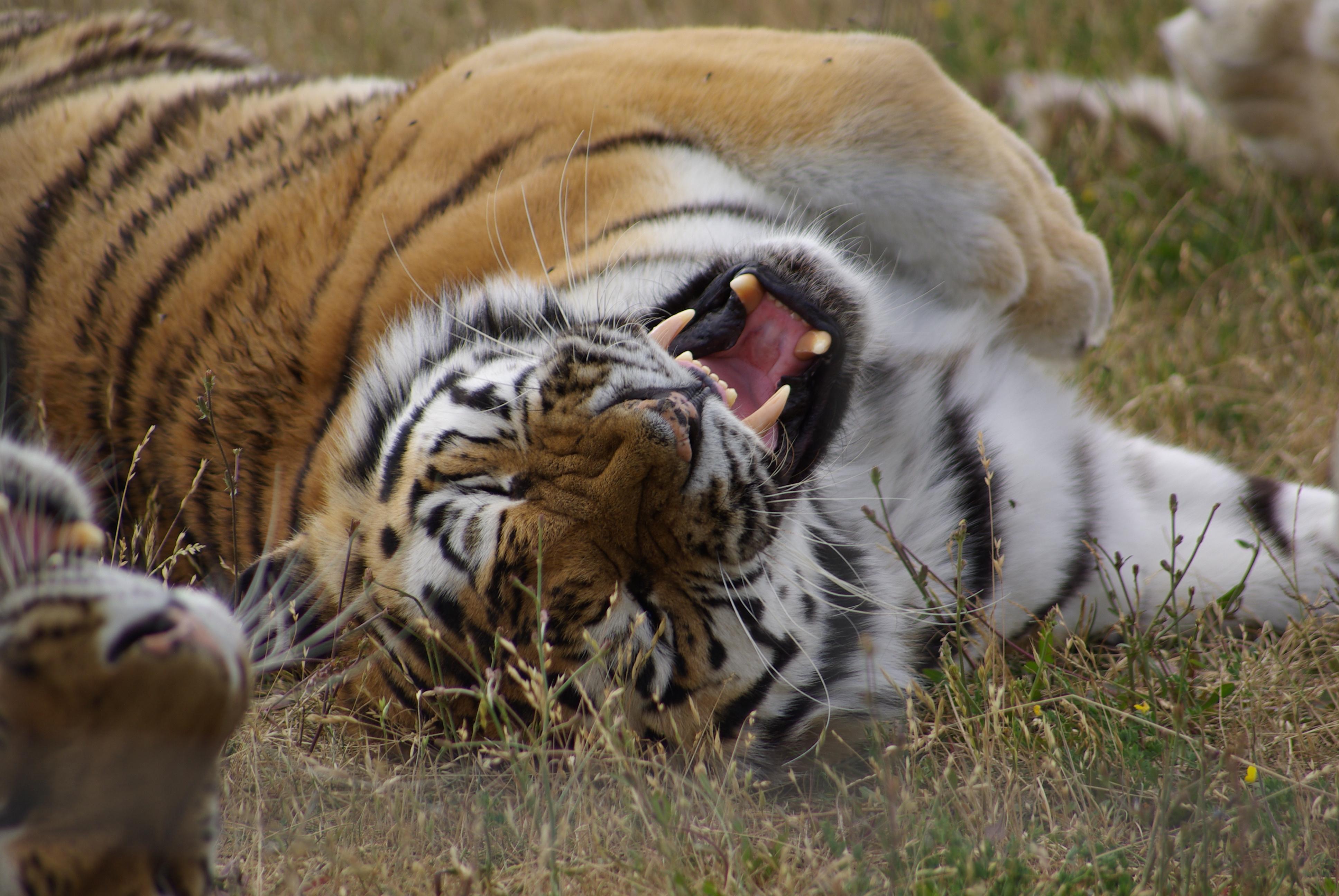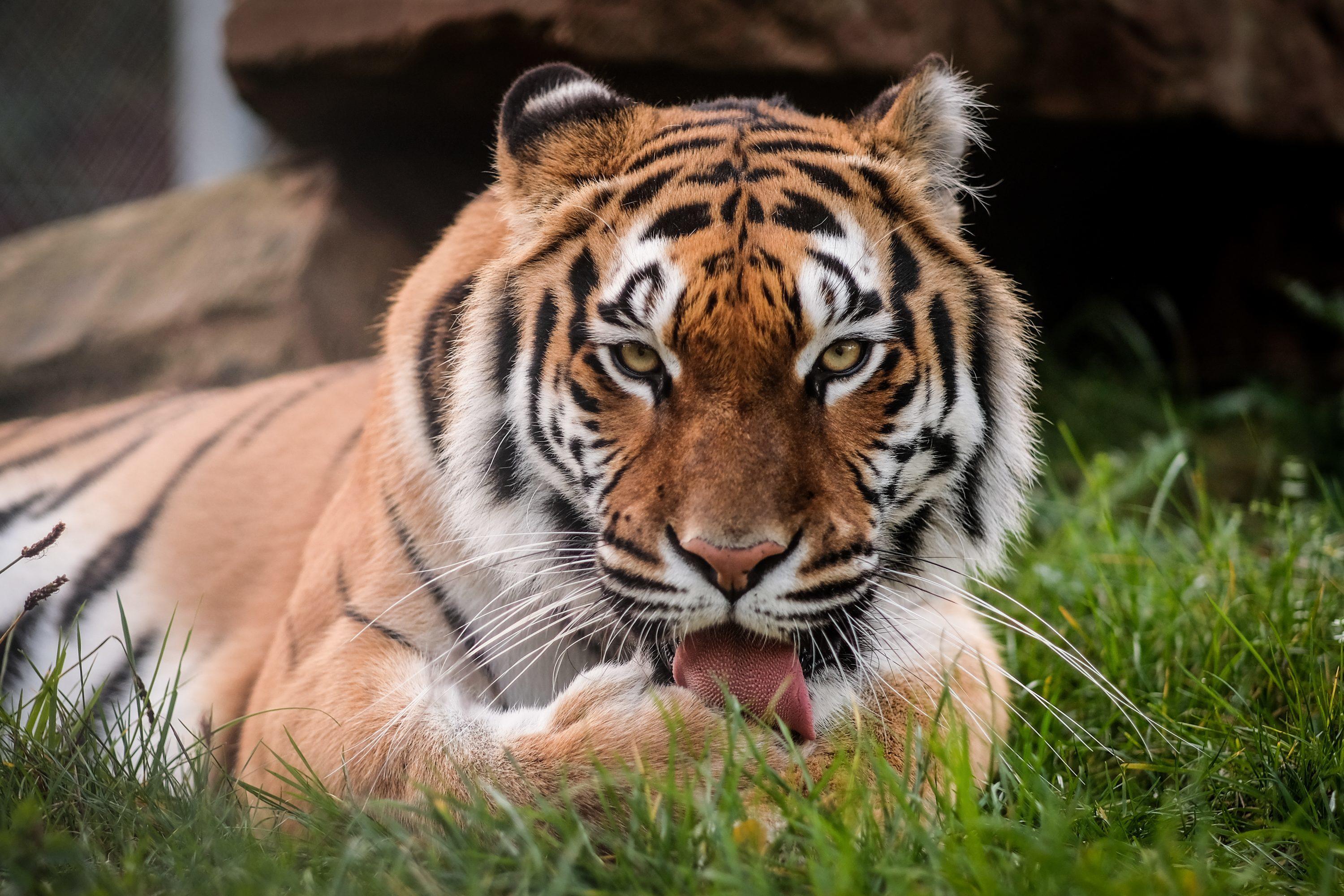
About Tigers – Also Called "Panthera Tigris"
The tiger is the largest predatory cat on earth
Due to its typical stripe pattern, the tiger is indistinguishable.
The Siberian tiger represents the largest subspecies, and male animals can become in some cases even over 300 kg in weight and reach a body length of up to 2.9 meters. Specimens of the Sumatran tiger as the smallest subspecies, and weigh just 75 to 140 kg, and grow up to 1.4 meters long. The distribution area of all subspecies is in Asia.
Like a fingerprint in humans, the tiger's stripe pattern is unique to each animal. It imitates the play of light and shadow of the surrounding vegetation and serves as camouflage when hunting. At dusk, the tiger sneaks as close as possible to its prey, which it then attacks at lightning speed with a few powerful leaps from ambush, tears down and kills with a throat or neck bite. Depending on the area of distribution, the tiger feeds on deer, wild boar and wild cattle, which way up to an astonishing 1,000 kg. Also monkeys, birds, reptiles and fish are captured. After a successful hunt, a tiger eats up to 20% of its own body weight in meat in one night – several times its average daily food requirement.
The tiger's dentition is specially adapted to killing prey and eating meat. The 7-9 cm long canine or fang teeth are deeply anchored in the jawbone and can withstand enormous forces when biting down. The fangs form a kind of "scissors" at the side for cutting off meat. With grinding movements of the powerful jaw, bones can also be ground to a fine pulp and eaten. With the rough tongue the tiger rasps off finally also smallest meat remainders of bones and utilizes the loot thus optimally.

Scientific classification
| Order | Carnivora |
| Suborder | Feliformia |
| Family | Felidae |
| Subfamily | Pantherinae |
| Genus | Panthera |
| Species | Panthera tigris |
| Binominal name | Panthera tigris (Linnaeus, 1758) |
The tiger belongs to the order of carnivores and the family of cats. These are further divided into big cats and small cats. As the name suggests, the big cats tend to include the larger representatives such as tiger, lion, leopard, snow leopard and jaguar. However, the genetic relationship is the decisive criterion for the assignment to one of the groups. It is determined by DNA analysis. For example, the rather large puma does not belong to the big cats.
The construction of the hyoid bone also serves as a distinguishing feature. This bony attachment of the tongue muscle in the cat's throat has a characteristically different structure in the two groups and enables different vocalizations. Small cats, unlike big cats, are able to purr continuously as they inhale and exhale. Big cats, on the other hand, can roar loudly, which is not the case with small cats.
The tigers have divided into nine subspecies in the course of evolution, but three of them are already extinct (Caspian tiger, Bali tiger, Java tiger). One assumes that also the South Chinese tiger in the wild is meanwhile extinct and is probably only still existing in zoos. The Malaysian tiger is so similar to the Indochinese tiger that it was recognized only in the year 2004 by scientists due to gene analyses as own subspecies.
The probably most known subspecies of the tiger are the Siberian tiger, also called Amur tiger, (Panthera tigris altaica), the Bengal tiger, also known as the Royal Bengal Tiger (P. t. tigris) and the Sumatran tiger (P. t. sumatrae).
Did you know…?
How does a tiger's way of life look like?
Outside the mating season, tigers live as loners. Only females and their young stay together for a certain period of time. Tigers are very territorial. The territorial boundaries are regularly marked by anal gland secretions, excrement and scratch marks and defended against conspecifics. While the territories of the females are quite small and they often keep them for their whole life, male tigers claim very large territories, which overlap with several female territories.
The size of a territory is always dependent on the food supply. There are areas in Nepal, in which according to investigations, 8 animals live on 100 km². Female territories are on average about 23 km², male territories about 68 km². In parts of Russia with clearly smaller prey animal density, however, only one tiger lives on a 100 km² area. The territories of the tiger females cover 200-400 km² here!
Female tigers reach their sexual maturity approximately at the age of 3 to 4, males with 4 to 8 years. A male mates with several females, whose smaller territories lie within its large territory, the females mate usually only with this one male. Females ready to mate attract the male with scent marks. Once the mates have finally found each other, they stay together for a period of a few days and mate up to 50 times a day. The frequency is necessary due to the so-called induced ovulation, which is typical for cats, in order to increase the chances of conception. This refers to the fact that ovulation is only triggered by the act of mating.
After a gestation period of about 103 days, usually 2-3 cubs are born. They are born blind and weigh approx. 800-1,600 g. The mother nurses the young for 6-8 months and later teaches them all things essential for survival, such as hunting. Only when the permanent canine teeth break through at 12-18 months, a tiger can take care of themselves independently. At about 2 years of age, cubs finally go their own ways. Female offspring often settle near the mother, males move further away. In nature, a tiger rarely reaches an age of up to 15 years; in human care, they can live up to 26 years.

Where do tigers live and how many are left in the wild?
The original form of the tiger lived about one million years ago in the area of today's southern China and spread from there over all of Asia. The original habitat of the tiger has been decimated and is only a fraction of what they used to be. Today the last tiger populations live only in small rest-areas of the original spread-area from India to China and Southeast Asia, as well as in the north beyond the Amur up to the eastern Siberia. In the southeast, the tiger is spread as far as Indonesia and lives on the island of Sumatra.
The tiger populates mostly different habitats, on the one hand, they feel well in the damp-warm tropical forests of Southeast Asia, on the other hand however just as in the dense grassland at the foot of the Himalayas or the coniferous and birch forests of the Russian Taiga, where the temperatures can fall on up to under - 30°C. Decisive criteria for the habitat of the tiger are dense vegetation, sufficient prey animals, as well as in proximity to water.
A good 100 years ago, it is estimated that there were still about 100,000 tigers in the wild. By 2009, the population had been decimated to just 3,200 animals worldwide. Three of nine subspecies have even now irretrievably disappeared from our planet. First the Bali tiger in the 1940s, then by the 1970s the Caspian and the Java tiger. There is currently no evidence of wild South Chinese tigers, and thus it probably exists only in zoos. The International Union for Conservation of Nature (IUCN) classifies the tiger overall as critically endangered, the Sumatran tiger even as endangered. Since 1975, the species has been classified in Appendix I of the Washington Convention on International Trade in Endangered Species (CITES). Tigers are protected throughout their range and hunting of these animals is prohibited everywhere, as is any international trade in tiger products. Nevertheless, poaching and trade in tiger components on the black market are still commonplace. Further intensive efforts to extensive protection measures are inevitable, in order to stop the progressive reduction of the tiger population. Fortunately, the measures taken so far to protect the species have already shown small successes and, according to recent studies, the global tiger population increased slightly again to 4,688 - 6,250 individuals in 2023 (estimation of the Global Tiger Forum).
Nevertheless, the population figures remain alarming. According to WWF, only 4,282 Bengal tigers, 760 Siberian tigers, 600 Sumatran tigers, 150 Malayan tigers and 183 Indochinese tigers still existed in the wild in 2016.
While populations endangered in the wild, there are a surprisingly large number of tigers of various subspecies in human care. It is estimated that about 20,000 tigers live in enclosures worldwide. Surprisingly, only about 1,000 tigers are accounted for by zoological institutions, primarily in Europe, the United States and Japan. A staggering number of about 5,000 tigers live in private enclosures in the U.S. alone. Another 5,000 individuals in other private enclosures, mainly in China. Special tiger parks exist there, in which keeping up to 800 tigers is no rarity.

Siberian tiger Varvara at TIERART
Which threat is the tiger exposed to?
As the largest predatory cat on earth, a healthy, fully-grown tiger has no natural enemies – except for humans, whom it has nothing to oppose.
The increasing disappearance of its natural habitats, but also its hunting by poachers threaten the worldwide tiger population. Its former range has shrunk by more than 90% to date. Of an estimated 100,000 tigers that lived freely 100 years ago, only just 4,000 - 6,000 individuals remain.
Rapid population growth on the Asian continent is necessitating more and more development of the remaining forest areas and the construction of roads and settlements. Also, more and more agricultural land and plantations are being created to grow food. Inevitably conflicts arise between the people and the tiger if a settlement or a plantation develops in the tiger's range. If it is classified as a danger for humans and farm animals, this usually means its death.
The retreat areas for the tiger do not only become constantly smaller they also become strongly fragmented, which makes the exchange between the populations isolated from each other more difficult on a long-term basis. The depletion of the gene pools makes the animals more susceptible to certain diseases and favors inbreeding effects.
Another factor – despite increasingly strict laws – threatens the survival of the tiger: human superstition. For more than 1,000 years, tiger products have been used in traditional Asian medicine, especially in China.
While, for example, the bones are said to help against rheumatism, among other things, eyeballs are used against epilepsy and malaria, claws against sleep disorders or teeth against fever, rabies and asthma. Tiger brain is supposed to work against laziness and pimples, tiger penis is processed to aphrodisiac love potions and tiger fat is even supposed to heal leprosy. The belief in the healing power of various body parts of the striped big cat exists until today.
Thus, it is not surprising that despite the meanwhile worldwide hunt, trade and use prohibitions further tigers are poached and illegally traded. China also imposed a national trade ban on tigers and their components in 1993. Hunting was banned and poaching is punishable by death. To date, there are no legal drugs with tiger ingredients on the market - but the black market is still booming.
Prices of about 7,000 US dollars for 1 kg of tiger bones, unfortunately, continue to make hunting tigers a lucrative business for poachers.



